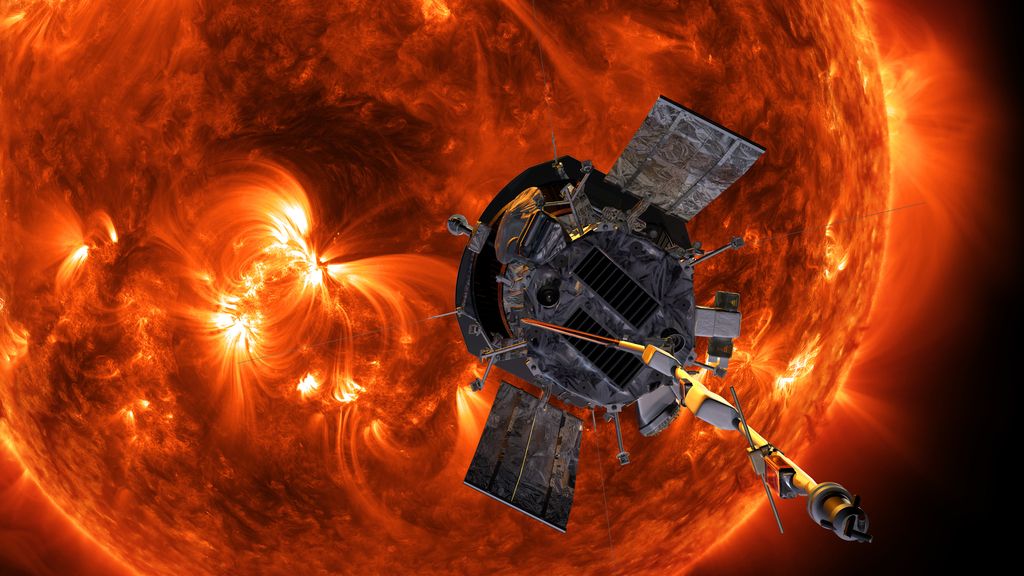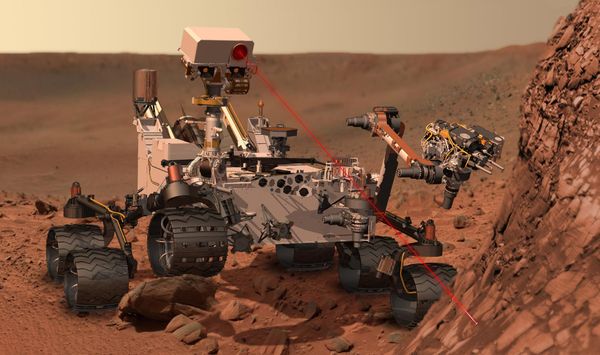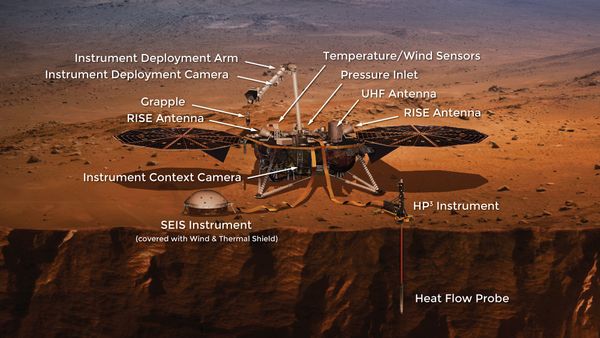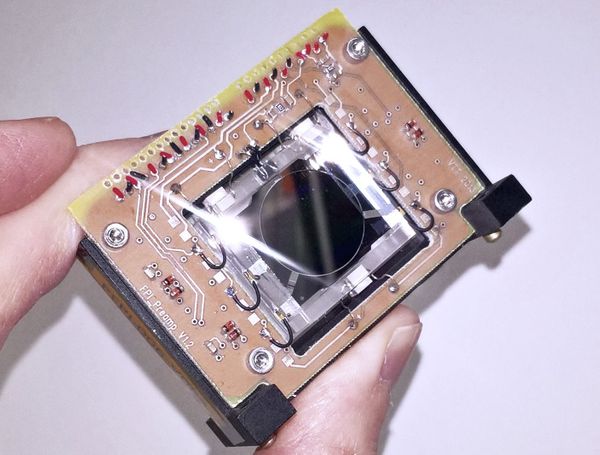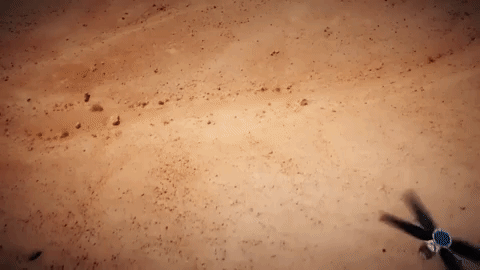On August 12th, a Delta IV Heavy rocket launched NASA's Parker Solar Probe onto a trajectory through the Sun's upper atmosphere, or corona. Over the next seven years, the probe will make 24 orbits around the Sun, using 7 gravity assists from Venus to gradually fly closer and closer to our home star.
Parker Solar Probe is humanity's first spacecraft to directly sample a star. The probe will make its first close approach this November and continue measuring the Sun and its corona for the next six years. Cover image and animation credit NASA.
The Parker Solar Probe is on a mission to touch the Sun. That sounds a little misleading since the Sun is a fiery ball of plasma, but it's true- the probe will be the first to fly through the Sun's upper atmosphere, or corona, and take measurements from within it. A suite of instruments on board will take samples of the energized coronal particles to investigate their energies, quantities, and other properties that can't be directly measured by remote observatories.
For example, the corona reaches temperatures on the order of millions of degrees Fahrenheit, while the surface (the point beneath which the Sun becomes opaque) only heats up to tens of thousands of degrees F. Scientists suspect the reason for this difference of multiple orders of magnitude in temperature has something to do with magnetic interactions in the corona, but it's difficult to theorize mechanics without data on what's happening there. This is where the Parker Solar Probe comes in.
Eugene Parker's Solar Wind

On August 31, 2012 a long filament of solar material that had been hovering in the sun's atmosphere, the corona, erupted out into space at 4:36 p.m. EDT. The coronal mass ejection, or CME, traveled at over 900 miles per second. Credit: NASA/GSFC/SDO
The corona is the Sun's atmosphere that extends more than 18 million miles from the surface. These particles don't just stop, though. The solar wind, as its known, is a stream of particles emanating from the Sun at high energies and continue through interstellar space. This constant stream of magnetized solar material flows outward at 800,000-5,000,000 miles per hour, and can have high energies that are dangerous to life and satellites alike. Huge bursts of particles periodically spew into the solar system all at once through Coronal Mass Ejections (CMEs) and can cause all kinds of damage to satellites, electronics, and organisms here on Earth.
Coronal Mass Ejections are explosions of energized particles from the Sun. To learn more about CMEs and solar observatories in space, listen to our interview with Terry Kucera about her work with STEREO, a pair of solar observatories that study these mechanisms of the Sun.
The Sun's corona has puzzled physicists and astronomers with every solar eclipse for more than 150 years. Through the early 20th century, observations of magnetic field activity on Earth and studies of the Sun led physicists to postulate that electrons and positive ions were emanating from the Sun. Later in the 1930s, astronomers estimated the corona's temperature to be millions of degrees, which we have now confirmed to be true. In the 1950s, studies of comets pointed out that comet tails always point away from the Sun.[1]
The science history of studying the Sun's corona is fascinating. It's full of mystery, twists, turns, and a healthy dose of physics. Read NASA's article for the whole story.
It wasn't until 1958 that Eugene Parker put the pieces of this puzzle together. But when Parker, the probe's namesake, proposed his theory that the heat flowing from the Sun, energized particles, and comet tails were the result of the same phenomenon, his idea for the "solar wind" was largely dismissed by the scientific community. He was finally proven correct when Mariner II, the first successful interplanetary mission, collected data on its way to Venus.[2]
Now 60 years later, the Parker Solar Probe (PSP) will investigate the mechanisms that create Parker's solar wind. By taking measurements from within, scientists hope to gain a better understanding of the fundamental processes of solar weather, and perhaps discover new electromagnetic dynamics at work. Moreover, these processes inform our concepts of what happens inside all stars, and the Sun is the only star we can study up close.
The Mission
Today we have a large body of observational data on the corona, but it has all been collected from a safe distance, around 93 million miles away. Parker Solar Probe will get up close and personal, making high speed passes straight through the hot corona.
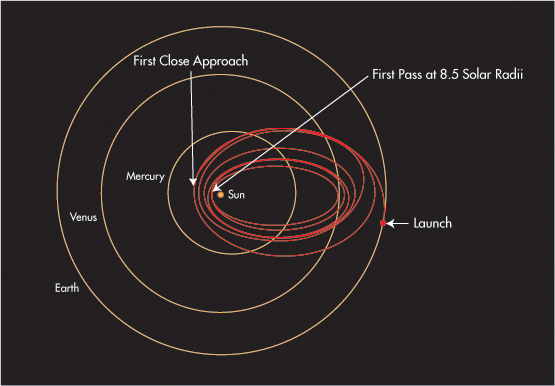
Parker Solar Probe will inch its way closer to the Sun over its 24 orbits and seven year mission life. By NASA, via Wikimedia Commons.
Parker Solar Probe will make seven close passes with Venus during it's seven year mission life, using the planet's gravitational pull to slow it down. With each pass, the probe's perihelion (closest approach to the Sun) gets closer and closer to the solar surface. The probe will fly within 15.4 million miles of the Sun the first time by this November, a little over half the distance between our star and Mercury. By 2024 Parker's perihelion will drop to a little over 4.26 million miles, where it will continue to orbit the Sun for the rest of its life.[3]
NASA Goddard has released a whole slew of mesmerizing animations for each phase of the mission. Watch them here.
The Spacecraft
NASA says Parker Solar Probe will touch the sun, but I like to think that the Parker Solar Probe is tasting the Sun, too. It's using all five senses in fact--hearing (FIELDS), sight (WISPR), Taste (SWEAP, low sensitivity composition), Smell (IS☉IS, high sensitivity composition), and Touch (the spacecraft feels the heat!).[4]
Hearing: Fields Experiment (FIELDS) - Space Sciences Lab at UC Berkeley
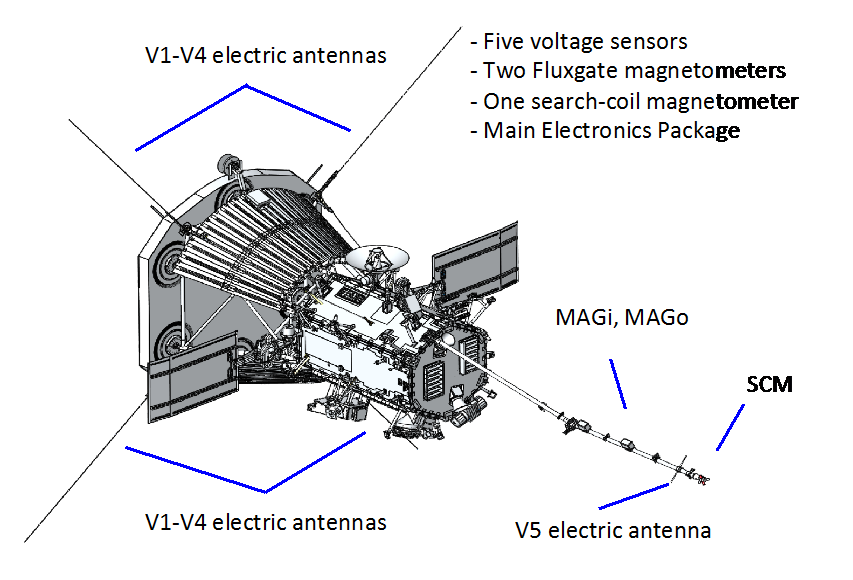
FIELDS uses a suite of electromagnetic sensors to measure waves and turbulence in the solar wind. Image credit NASA/APL.
WHAT: Measures waves and turbulence in the inner heliosphere with high temporal resolution.
HOW: Four electric field antennas are mounted near the edge of the heat shield. A voltage sensor, two fluxgate magnetometers, and a search coil magnetometer are mounted on the magnetometer boom. The fluxgate magnetometers are specialized for measuring large-scale features further away from the sun, while the search coil magnetometer samples with high time resolution (2MHz) when the probe is closest to the Sun.[5]
WHY: The corona, like any atmosphere, is a fluid. We usually think there's no sound in space, but that's not entirely true. There's no sound in a vacuum, but inside the corona sound, or pressure waves are able to propagate. Since the corona is composed of charged particles, it is heavily influenced by the Sun's magnetic field, which can accelerate the fluid to supersonic speeds. FIELDS aims to understand how pressure waves, shocks from supersonic flow and the electromagnetic fields that lead to the stunning coronal loops that form as solar plasma follows the contours of the Sun's magnetic field.
Sight: Wide Field Imager for Parker Solar PRobe (WISPR) - Solar and Heliophysics Branch at Naval Research Lab
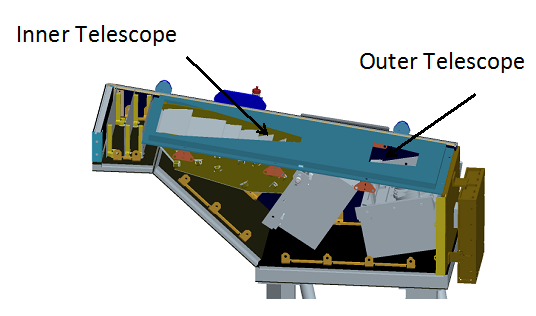
WISPR is the only imaging instrument on the spacecraft. Its data will be used to map 3D coronal structures that other instruments will sample as the probe passes through them. NASA Goddard has some excellent visualizations to better understand how it works. Image credit NASA/APL.
WHAT: Images large scale coronal features before probe passes through them to derive the 3D structure of the solar corona.[6]
HOW: Radiation-hardened 2k-by-2k pixel CMOS imaging sensors are placed behind two nested telescopes.[7]
WHY: Having images from the craft itself helps correlate large scale coronal structure to detailed in-situ measurements from other instruments. While other observatories on Earth or in orbit are capable of observing the Sun, WISPR will image the solar wind, shocks and other structures in the corona and inner heliosphere as they approach and pass the spacecraft.
Taste: Solar Wind Electrons Alphas and Photons Investigation (SWEAP) Investigation - Smithsonian Astrophysical Observatory, Space Sciences Lab at UC Berkeley
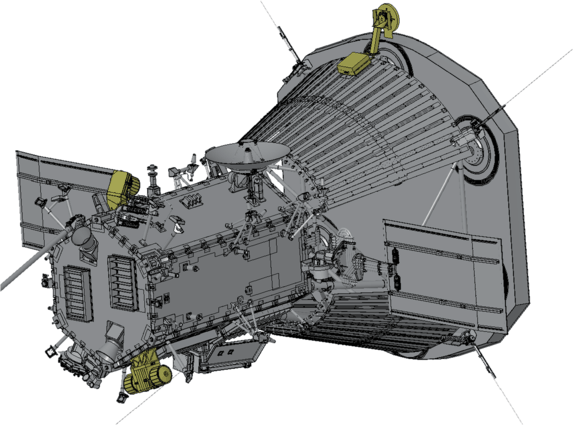
The Solar Probe Analyzers (SPAN) are placed in the shade of the heat shield and are rotated such that their combined field of view covers the entire sky except what is obscured by the heat shield. The Solar Probe Cup (SPC) is exposed to view the sun directly. Image credit Kasper, J.C., Abiad, R., Austin, G. et al.
WHAT: Counts electrons, protons, and helium ions in the solar wind and measures their velocity, density and temperature.
HOW: SWEAP consists of a suite of instruments. The Solar Probe Cup (SPC) is a Faraday cup that is exposed directly to the Sun and measures ion and electron fluxes and flow angles as a function of energy. The Solar Probe Analyzers (SPAN) are electron electrostatic analyzers that sort collected particles based on mass and charge ratios to identify different ion species.[8][9]
WHY: SWEAP will produce velocity distributions with high energy and angular resolutions, enabling observations of coronal structures such as shocks and reconnection events.
Smell: Integrated Science Investigation of the Sun (IS☉IS) - Johns Hopkins Applied Physics Lab, Caltech, SwRI, NASA Goddard
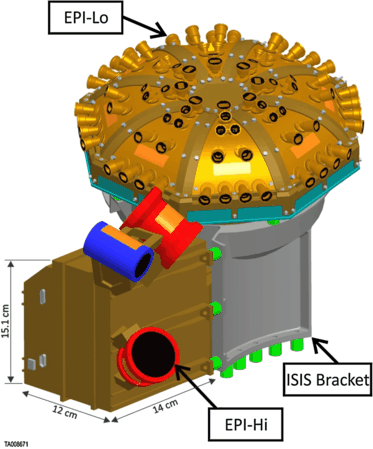
The 83 telescopes between EPI-Lo and EPI-Hi collimate energetic particles into narrow pathways, which allows their speed and energy to be measured while also registering which aperture they passed through. Image credit McComas, D.J., Alexander, N., Angold, N. et al..
WHAT: Measures electrons, protons and ions over a range of energies across a wide field of view.
HOW: Two Energetic Particle Instruments (EPIs) measure the energy and species of ions and electrons across a wide range of energies. EPI-Lo measures low energy particles using 80 tiny telescope apertures that have a combined field of view of almost a complete hemisphere. EPI-Hi measures high energy particles using a combination of three telescopes that together make five large field of view apertures. IS☉IS resides at the back of the spacecraft, shielded from direct sunlight.[10]
WHY: By observing a large field of view, IS☉IS will provide insights to where these energetic particles originate, how shocks and turbulence affect accelerations of these particles, and how the electrons and ions propagate from the corona.
Touch: Solar Panels and Thermal Management
One obvious question to consider with this mission is "why won't Parker Solar Probe melt?" The answer is simpler than you might think.
Temperature is a metric to explain how much energy is in something. Heat is the metric to explain how that energy is transferred, and this is the what worries spacecraft engineers. Although the corona can reach temperatures of several millions of degrees, its density is very low so a small fraction of the heat is transferred to the probe. The surface of Parker Solar Probe's heat shield on closest approach will reach 2500F, which is cooler than 5 million but still hotter than lava, which only gets up to 2200F.[11]
It is still a major challenge to keep the instruments and other spacecraft components at temperatures where they are happy (~85F). To accomplish this, PSP uses a heat shield called the Thermal Protection System (TPS) to shade the rest of the spacecraft. The heat shield is a carbon plate-carbon composite foam-carbon plate sandwich coated in white ceramic paint. The white paint does some of the work by reflecting as much of the heat as possible, reducing the amount of heat that is absorbed and transmitted through the TPS. The carbon composite sandwich is made of regular carbon fiber plates on either end, filled by 4.5 inches of carbon composite foam. The foam core is 97% hollow, which greatly increases its thermal resistance and has a side benefit of being very light. The 8 ft diameter TPS only weighs 160 lbs.[12]

The angle of the small solar array "tabs" on the end is autonomously controlled by the spacecraft to optimize power and cooling capacity. According to Mary Kae Lockwood, a spacecraft system engineer for Parker Solar Probe from APL, a one degree change in the array angle of one wing would require 35 percent more cooling capacity. Image credit NASA/APL.
As one might expect, the Parker Solar Probe is powered by solar arrays. An interesting problem arises because of this: solar panels are designed to harvest energy by absorbing light (and therefore heat). But, as always, NASA engineers have this one figured out.
The spacecraft's solar panels retract into the shade of the heat shield on close approach, leaving all but a little tab of the arrays exposed to the Sun, but the solar panels still absorb a lot of heat. To keep temperatures manageable, the arrays are water-cooled as well. About a gallon of water is piped across the back side of the panels then the heat is rejected with two radiators. The water tank is heated to keep it from freezing, and pressurized to raise the boiling point up by about 25%. At nominal capacity, the cooling system is able to reject 6,000W of heat.[13]
Getting the science back to Earth
Once Parker Solar Probe collects all this data, it has to get it back to Earth. The communications system has two functions--transmitting science data, and speaking to mission controllers (receiving commands and sending health updates or telemetry). All communication between ground stations and the spacecraft will be managed by NASA's Deep Space Network.[14]
After making a close pass with the Sun, the probe will send home the measurement data using a 0.6 meter high gain antenna mounted to the body of the spacecraft. During the science downlink period, high rate transmissions will send science data daily for 10-24 hours per day until all data is sent.
The probe will keep ground control informed of the spacecraft's status with less frequent downlinks of real-time health and telemetry data sent from two fan-beam antennas or a two low gain antennas in contingency situations. During the cruise phase of its orbit, these downlinks will occur three times per week. During a solar encounter phase, the probe will send out a beacon tone three time per week indicating health and status (but not full telemetry).
"Solar wind," Wikipedia. ↩︎
NASA Goddard Space Flight Center, "Eugene Parker Imagery." ↩︎
"Parker Solar Probe - Mission and Timeline", Johns Hopkins Applied Physics Lab. ↩︎
"Parker Solar Probe Press Kit", NASA. ↩︎
"Parker Solar Probe Instruments: FIELDS", Department of Physics, University of California at Berkeley. ↩︎
"WIde-Field Imager for Solar Probe Plus (WISPR)", Space Science Division, US Naval Research Laboratory. ↩︎
Vourlidas, A., Howard, R.A., Plunkett, S.P. et al. "The Wide-Field Imager for Solar Probe Plus (WISPR)" Space Science Reviews (2016) 204: 83. ↩︎
Kasper, J.C., Abiad, R., Austin, G. et al. "Solar Wind Electrons Alphas and Protons (SWEAP) Investigation: Design of the Solar Wind and Coronal Plasma Instrument Suite for Solar Probe Plus," Space Science Reviews (2016) 204: 131. ↩︎
Author's note: The Solar Probe Cup is a marvel on its own. I highly recommend reading through the SWEAP technical paper to see some excellent engineering and great visuals of this instrument. ↩︎
McComas, D.J., Alexander, N., Angold, N. et al. "Integrated Science Investigation of the Sun (ISIS): Design of the Energetic Particle Investigation," Space Science Reviews (2016) 204: 187. ↩︎
"Why won't Parker Solar Probe melt?"," NASA/APL. ↩︎
"Cutting-Edge Heat Shield Installed on NASA’s Parker Solar Probe," NASA/APL. ↩︎
"Cool Power," NASA/APL. ↩︎
Parker Solar Probe - former SPP (Solar Probe Plus) Spacecraft Mission," eoPortal. ↩︎

